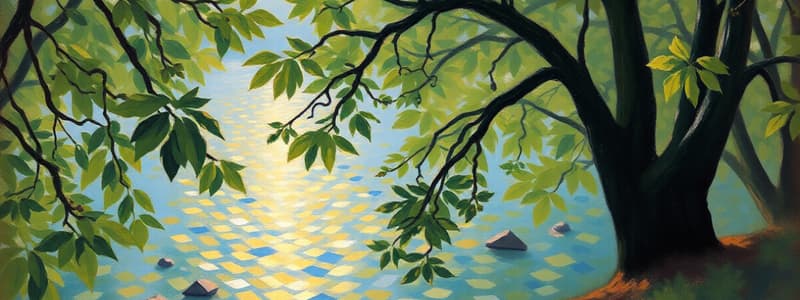Podcast
Questions and Answers
What distinguished Claude Debussy's musical style during his time at the Paris Conservatory?
What distinguished Claude Debussy's musical style during his time at the Paris Conservatory?
- His virtuosic piano performances.
- Strict adherence to traditional musical rules.
- His creation of a dreamy atmosphere through unconventional methods. (correct)
- His focus on dramatic effects using traditional chords.
How did Debussy's use of chords differ from the common practice of his era?
How did Debussy's use of chords differ from the common practice of his era?
- He avoided using chords altogether, focusing solely on melody.
- He prioritized chord progressions to create complex harmonies.
- He used chords primarily to evoke a specific mood or atmosphere. (correct)
- He employed chords for dramatic effect, following established norms.
Which instrument plays the central melody in Debussy's Prélude à "L'après-midi d'un faune"?
Which instrument plays the central melody in Debussy's Prélude à "L'après-midi d'un faune"?
- Oboe
- Violin
- Clarinet
- Flute (correct)
Which instruments did Debussy omit from Prélude à "L'après-midi d'un faune" to maintain a gentle atmosphere?
Which instruments did Debussy omit from Prélude à "L'après-midi d'un faune" to maintain a gentle atmosphere?
Which term best describes Debussy's compositional style?
Which term best describes Debussy's compositional style?
What was Debussy's primary goal in using 'floating harmonies, shimmering notes, and delicate tones'?
What was Debussy's primary goal in using 'floating harmonies, shimmering notes, and delicate tones'?
Clair de Lune is a part of which larger Debussy composition?
Clair de Lune is a part of which larger Debussy composition?
What characterized Debussy's piano playing, despite not being considered a virtuoso?
What characterized Debussy's piano playing, despite not being considered a virtuoso?
What is the original source of inspiration for Prélude à "L'après-midi d'un faune"?
What is the original source of inspiration for Prélude à "L'après-midi d'un faune"?
What is indicated about Debussy's intentions for Prélude à "L'après-midi d'un faune" ?
What is indicated about Debussy's intentions for Prélude à "L'après-midi d'un faune" ?
Flashcards
Claude Debussy
Claude Debussy
French composer known for revolutionizing classical music with impressionism.
Impressionism in music
Impressionism in music
A style focusing on evoking moods and impressions rather than strict form.
Floating harmonies
Floating harmonies
Harmonies that create a sense of fluidity and dreaminess in music.
Suite Bergamasque
Suite Bergamasque
Signup and view all the flashcards
Clair de Lune
Clair de Lune
Signup and view all the flashcards
Prélude à 'L'après-midi d'un faune'
Prélude à 'L'après-midi d'un faune'
Signup and view all the flashcards
Debussy's unique instrumentation
Debussy's unique instrumentation
Signup and view all the flashcards
Asian-inspired scales
Asian-inspired scales
Signup and view all the flashcards
Natural sound textures
Natural sound textures
Signup and view all the flashcards
Paving the way for 20th-century music
Paving the way for 20th-century music
Signup and view all the flashcards
Study Notes
Debussy's Musical Style
- Debussy, a French composer, significantly altered classical music in the late 1800s.
- His approach diverged from traditional methods.
- He employed "impressionist" techniques— floating harmonies, shimmering passages, and delicate tones —to evoke a dreamy atmosphere.
Debussy's Early Conservatory Studies
- Debussy studied music at the Paris Conservatory.
- His teachers, however, found his "atmospheric and untraditional" style unusual and potentially risky.
- Debussy, while not a piano virtuoso, was skilled at creating various piano sounds and textures using skillful use of pedals and keys.
Debussy's Piano Compositions
- His compositions, like Suite bergamasque, required performers to use techniques beyond traditional piano methods.
- He influenced other composers with his unique use of scales and chords that paved the way for 20th-century music.
Prélude à l’après-midi d’un faune
- This 1894 prelude caused a sensation.
- It was inspired by a poem and depicts a faun playing panpipes.
- The piece is characterized by a gentle melody played on a flute.
- The absence of typical instruments like trumpets or trombones was unusual.
- The piece was composed as part of a suite.
- It exemplified Debussy's approach to drawing atmosphere and evokes a dreamy, somewhat introspective feeling.
Suite Bergamesque
- One of his most famous works featured the "Clair de Lune" (Moonlight) segment
- This particular piece is known for being elegant and gently melancholic.
Studying That Suits You
Use AI to generate personalized quizzes and flashcards to suit your learning preferences.




